Home |
Publikációk |
Rádiós felvételek |
Home |
Publikációk |
Rádiós felvételek |
|
|
The Logic of Crisis Cycles In: IV. World Congress of Soviet and East-European Studies, Harrogate, England 1990.
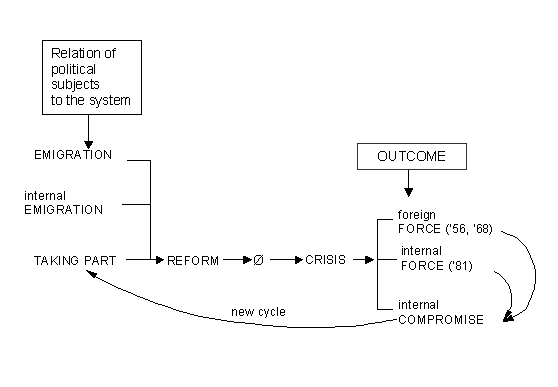 During these years of party-states some variants of mono-centric political system had been prevailing in Central-Eastern-Europe (CEE), from totalitarian one/party system to authoritarian or pragmatical hegemonic one (Poland), all excluding competition for governing (see G. Sartori's model - Figure 2.). 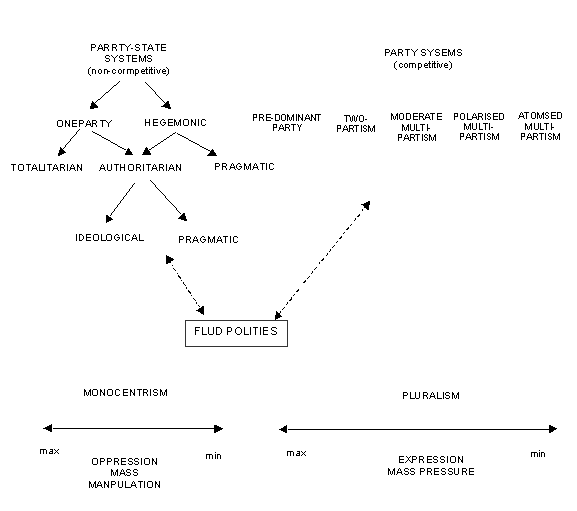 There were differences from country to country and the passing decades had brought a kind of "softening up" in using the dictatorial means of power, but the basic structure of and the monocentric core of these political systems remained (irrespectively of the fact that there used to be some formally multi-party systems but only with "satellite" organizations of the ruling communist party). In these mainly monopolistic structures decisions were made on the top and were realized from above (see Figure 3.). 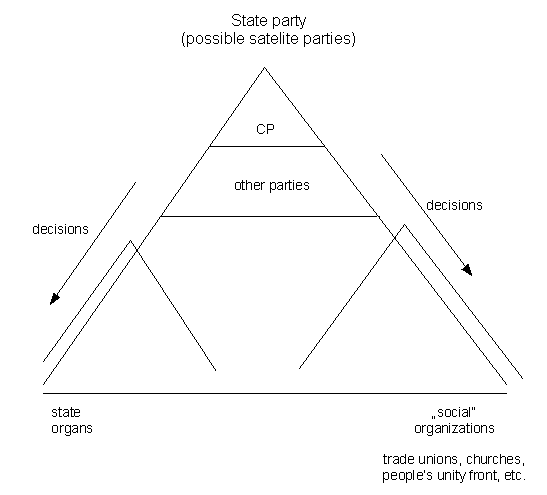 Subjects or citizens living in these systems had three choices in relation to the existing system: 1. emigration, 2. internal emigration, 3. taking part or in other words "building him-, or herself" into the system. As far as emigration is concerned in most of the cases it used to be an illegal way of leaving these countries (there are of course exceptions: the Polish case on the whole or the Hungarian one in the late 1940s and in 1956. Hungary had three main waves of political emigration: the extreme right wing fled from the country at the very end of the II. World War; most of the leaders of the democratic parties left the country in 1947-48, and so did the masses of mainly young people in 1956. All streams were results of dramatic political changes. In case of staying at home - and at the same time refusing the system - you could choose passive resistance, or organizing some underground, illegal or semi-legal groups, movements, etc. The history of these alternative movements varies from country to country. In Hungary we had extreme leftists, Maoists in the late 1960s, had some intellectual efforts from the early 1970s, but only after Charta '77 had more intensive activity. The alternative movements gained strength from the early 1980s until they became more or less the basic frameworks of the new political parties at the end of the decade. After 1956 we never had any real mass movement against the party-state as the Solidarnosc in Poland. In case of "being built into" the system there are various possibilities: there were "band-wagon-jumpers", those who merely wanted to have a more profitable job and by all means, those who - on principal basis - did believe in the system. As far as changes are concerned the most important stratum of the non-refusers was that part of the political elite (members of bureaucracy, technocracy or logocracy) which did not believe in the system - at least not in the form it existed - but did believe in changing it from inside, usually step by step and not at once. They possessed certain means of power, could influence or make decisions, etc., but there existed a certain limit to their activity depending on the rigidness of the system (whether it channeled initiatives and moves by absorption, or excluded all view differing from the monolithic centre or the dictator (authoritarian leader). This limit could mean a total failure of REFORMS. The crises in CEE appeared in many forms as mass revolt in 1956 in Hungary, mass strikes in Poland, mass emigration from the GDR or massive disillusionment and losing interest in public affairs. The latter resulted in silence among people for decades in Czechoslovakia after 1968 and in Hungary after 1956 - partly because of the very relatively better level of private consumption. (Romania is a different case: there an "order of fear" was prevailing?). The "latent crises" sooner or later led to open ones with a radical destabilization of the old system and its institutions. During the Hungarian uprising this meant a kind of civil war. In Czechoslovakia in 1968 there was a sharp political debate going on but there was no important internal force using weapons or threatening with that. The acute crisis in both cases led to the action of the Soviet Army. (In 1968 there was only token participation of others including Hungary.). The "outcome" of the Hungarian 1956 and that of 1968 in Czechoslovakia in quite a different internal and international situation was the same: action of FOREIGN FORCE(S). (The scenario of crackdown of "Prague Spring" for the decision-makers in Moscow was the same as in 1956 in Hungary but it did not work as "well".) This scenario was for many reasons far from being applicable in 1981 in Poland though there was a permanent threat in the air: a warning letter to the Polish leadership from the CC of the Soviet CP on 5 June, 1981, or military maneuvers, among others those of the Soviet Army in the Gulf of Gdansk called "West 81" during the days of the 1st Congress of Solidarnosc, etc. The cyclical and long crises in Poland at last resulted in the use of INTERNAL FORCE. The third possible outcome - and in a workable political system the most simple and natural one - had never been realized before the Polish round-table agreement in April 1989: INTERNAL COMPROMISE. (In this case it was a real division of power, but not unlimited - there was a certain balance kept between the party-state and the legalized opposition, and this way the competition was not fully free either.) Using force to "solve" crises in all the three cases on the long run proved to be inefficient. History proved that FORCE is a tool only for freezing problems, but not for solving them. It can only bring delays for years or even for decades engraving and multiplying the troubles. In spite of it: let us try to examine whether it is possible to return to a compromise after using internal or international force? In my view only the Polish case can be considered something like that. It was realized only after a long series of crises, and as a result of strong massive pressure on the government from below combined with open-minded leadership of the party-state, and last but far from being least: combined with huge changes in international conditions. A basic factor of the external circumstances has changed when it turned out: the Gorbachov-led centre of power in Moscow is willing to tolerate an essentially different model of political and social system in CEE than their own one. I prefer to call the famous Kádár-model a system of pseudo-compromise, as there was no word of sharing power, and the so-called "policy of national unity" after the amnesty-decree in 1963 in reality meant unity only on the surface of political life. The "golden ten years" of this era (i.e. the years from early 1960s to the early 1970s) had brought changes within the political - and to a certain amount in the social - system of Hungary but without touching the hard core of those. We had limited reforms in the economy, some - not systemic - changes e.g. in the election system, etc. There were incosequent steps forward with slow pace, and consequent and fast steps backwards. On the whole, the totalitarian party-state was being softened up into a less coercive, authoritarian system. It allowed to revitalize limited autonomies in the life of the society (economy, human rights, etc.) and treated sub-groups by absorbing rather than excluding them if they - maybe only for the sake of the "facade" - accepted the ruling role of the communist party and did not speak - at least openly - against the Warsaw Pact, or the Soviet Union. Even during the 1980s, when the opposition/alternative groups were gaining strength, both players - the central organs of power and opposition - were mutually considering the other side's interests. They were "dancing" a kind of cautious and tentative "special ballet" while taking care: not to push the other one to the extreme end and not to make it totally impossible. (I am far from thinking that it was a fair game of equal parties.) In the GDR, Czechoslovakia, Romania or Bulgaria there was no compromise at all (Yugoslavia - as always - is a separate case). A possible new way in the model could have been a successful reform of the system in some of the CEE countries. During the last 40 years the progressive forces "being built in" could not produce it in any of the cases. Many researchers think: it happened this way because the monocentric system as such is not reformable. But in Poland, Hungary - and of course in Yugoslavia - there could be achieved temporary and partial results, and in case of a step-back the conservative old guard of the establishment was not able to annihilate all the changes. This way the next wave of reforms, the "new start" was possible from a higher level. Some progressive "tools" or facilities had been already built in the system and made the work easier (new - old? - ideas were partly accepted, economic or legal regulations were more free, etc.). But sharing power - which is the only real basis for an internal compromise - was not on the agenda of the reformers until the late 1980s, and paradoxically in some cases was not - at least openly - involved in the scenario of the opposition either. This may be one of the factors which later caused changing power, and changing the systems instead of reforming those in CEE in 1989-90. The "closed circle" in Figure 1, can be described in other way too: as György KONRÁD - and others did. In his view the history of Hungary in the last century as well as after the II. World War (and maybe the history of many other countries) is a sequence as follows: crisis-revolution-revenge/oppression-compromise-reform-crisis-revolution? and again from the beginning. The old "closed circle" of Figure 1 seems to be over now, as "PAX SOVIETICA" seems to be passing away. But it would be too much simplistic to say that the systematic changes in CEE are only the results of the present Soviet leadership's open-mindedness, which allows the countries of this region to go on a way they want to go. II. COMMENTS ON THE CHANGES OF POLITICAL SYSTEMS IN CENTRAL-EASTERN-EUROPE THE SCENARIO OF REFORM COMMUNISTS. THE MONOPOLISTIC AND THE HEGEMONISTIC MODEL. THE SCENARIO OF THE OPPOSITION: A SPECIAL PROCESS OF LEARNING. MODERATE CASES IN HUNGARY AND POLAND: OPPOSITION FOR KEEPING STATE-PARTY IN POWER? HISTORICAL LIABILITY TO EXTREMISM - OVERCOME IN 1989-90? SOURCES OF SYSTEMATIC CHANGE: NEW INTERNATIONAL FIELD OF FORCES OUTSIDE AND INSIDE POWER, FAILURE OF ECONOMIC AND POLITICAL MODEL. The so-called reform-communists of these countries wanted real changes, in most of the cases with a limited "devolution" or sharing power but at the same time keeping the basic power-structure. (In other words: changes with new forces absorbed into the system, but keeping the hegemony of state-party and having only limited competition for governing - see Figure 4.) 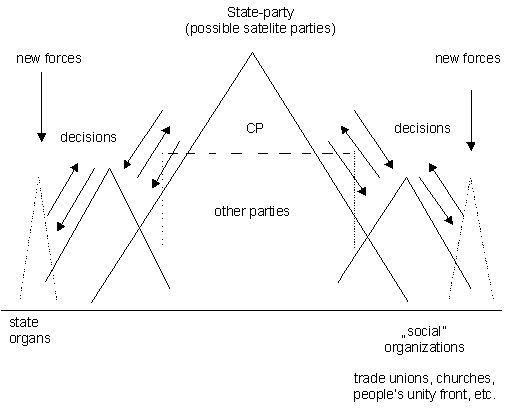 The extreme end of reform-communism lies beyond its original framework and it already can be called a kind of social-democracy, which means acceptance of free competition of parties, private property, etc. In the hegemonic model - never fully realized, perhaps in Poland a bit - there exists a relatively significant autonomy for the parliament (still subordinated) and a relative - i.e. limited - autonomy for the "social organizations" including possible satellite-parties. In this model the hard-core of the power-structure is the same as earlier but there is a kind of communication between the leadership and the - to a certain amount civil - society. The decisions are on principle made as a result of a process by articulating, negotiating and harmonizing interests from below and above. In this structure state organs and social organizations can be called "local peaks" of power (out of which you can have quite many) distributing decision-making to a certain extent: they are brought not only on the top and the realization of decisions can go on with a certain cooperation of various sub-groups of society. At the end of the 1980s reform-comunists (in a different way and not to the same extent) in the Eastern-European so-called reform-countries were striving to establish this hegemonistic model. The conservative "old-guard" wanted to keep the old monopolistic model, and the alternative political forces - the various groups of opposition - wanted a totally new, competitive multiparty-system with free elections (whether they had openly declared this or not). As a matter of fact, the scenario of opposition - still not legalized - varied from country to country and of course there were important differences within one country between the groups or movements. There seems to have been working a continuous "process of learning" for those forces who wanted or want to change the political systems in CEE. In 1956 in Hungary we can speak of a mostly spontaneous mass revolt with arms from below; in 1968 in Czechoslovakia there was a conscious reform-process, it started from above within the high-ranks of the communist-party - mainly Czeches - with the experience an instinctive mass-uprising from below with no arms; in 1980-81 in Poland there was a well-organized, peaceful mass-movement having already a well-trained leadership of intellectuals with a highly elaborated program. After the series of backlashes in the years of 1989-90 have brought INTERNAL COMPROMISE as a way of changing the system. In the late 1980s the opposition in the countries of CEE mostly wanted "real reforms" instead of the "pseudo-reforms" of the communists, but they had systematic change in mind. At the beginning of the 1980s in Hungary discussion was going on about "new reforms" or instead of those "developing the old one of 1968" (the latter was the position of the Kádár-led Politburo). In Poland e.g. in 1980-81 there were of course radicals who were openly speaking about "destroying" the old system, but at the end of the decade this kind of radicalism was not accepted as an "official" program for the main forces of opposition. In Hungary one of the main documents of the opposition about the transition was published in June, 1987 as a special issue of "Beszélő" (Speaker) by János Kis and his work mates (there were of course a lot of programmes). It was called Social Contract (Társadalmi szerződés). As the title refers to it this document was refusing the old Kádárist formula, but on the other hand it was for a step-by-step moderate transition. "The authors of Social Contract were thinking that there was no hope for partly pluralism in the near future, and taking this into consideration it is a better choice to limit the party's role (as a state-party - J.H.) and to build it into the legal system than to keep an unlimited party-power." They had considered the program of 1956 - i.e. multi-party system, self-management at the work-places and in local communities, national sovereignty and neutrality in foreign policy - was historically still valid, but "those demands can not be put on the agenda in the present political situation of the country, and we think that this situation will probably not basically change for a long time." The Polish round-table agreement reflects the same: accepting a certain parity of places in the new parliament showed that the leaders of Solidarnosc were thinking in terms of a limited power-sharing and judged totally free competition too early, or just thought: the central role of state-party must be preserved for a while for the sake of smooth and peaceful transition. Both in Hungary and Poland the forces of opposition over-estimated the real strength of state-parties. In order to understand the full meaning of general elections in the countries of CEE (mainly Poland, Hungary, and Croatia - GDR and Slovenia are a bit different cases) we must have a look at the old history of this region. In all cases the people have resolutely voted against the old system including reform-communists who had more or less opened the way for a real change. (As far as Hungary is concerned see Figure 5. and 6.). 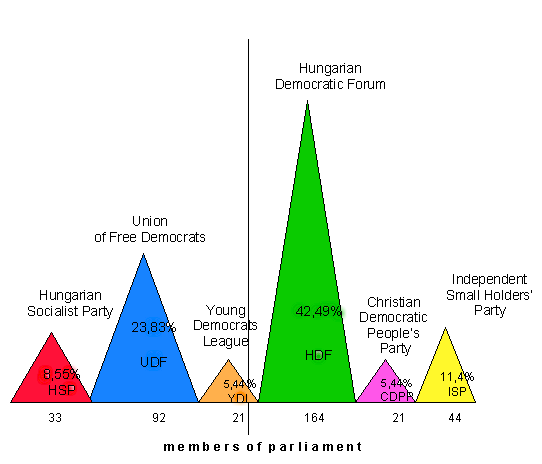  In Hungary it resulted in a lack of a strong centre-left party in the parliament. The reasons of this are older than the history of 20th century though the main factors lie in the years of PAX SOVIETICA. This region - Central-Eastern-Europe - during the last two thousand years used to belong alternately either to the Western or the Eastern World. This created a special liability to extremists for the political systems in transition mainly during the 20th century (see Figure 7.). In the years of 1989-90 in Poland, Czechoslovakia, in the GDR and Hungary (and no doubt in Slovenia) the swings to the extreme ends seem to have been avoided.  We must be aware of the fact that systematic change derives not only from the new field of international forces, and not only from the activity of semi-legal opposition and that of reform-communists from inside the power-structure. A basic source of the radical transition in CEE is the ineffective and lagging economic system, which proved to be not functioning on the long run at all. In the case of Yugoslavia we can not explain the transition for multiparty system by the collapse of PAX SOVIETICA as the country has been independent from Moscow from the late 1940s. But it used to have the same monopolistic one-party system with an authoritarian leader as in all the communist-led East-European states and this type of monocentric political system - in spite of all reforms - prevented economy from a dynamic development. A citizen of a Central-Eastern-European state used to have three choices: emigration, internal emigration or joining in the system. The transition-processes of 1989-90 showed that all the three groups have had a role to play in changing the political system. |

Home
Publikációk
Rádiós felvételek